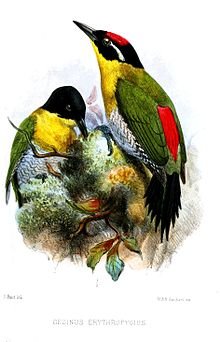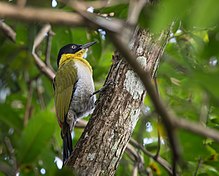Black-headed woodpecker
| Black-headed woodpecker | |
|---|---|

| |
| Female | |

| |
| Male | |
| Scientific classification | |
| Domain: | Eukaryota |
| Kingdom: | Animalia |
| Phylum: | Chordata |
| Class: | Aves |
| Order: | Piciformes |
| Family: | Picidae |
| Genus: | Picus |
| Species: | P. erythropygius
|
| Binomial name | |
| Picus erythropygius (Elliot, 1865)
| |
The black-headed woodpecker (Picus erythropygius) is a species of
Description

The black-headed woodpecker is a medium-sized bird at around 33 cm tall and 100-135g.[2] Adult birds have very distinct plumage and have a black face, yellow throat, green wings, a red lower back, and a white stomach.[3] They also have white/yellow eyes and some individuals have a thin white line from their eye to their neck.[2] Males have a red crown, while females have a completely black crown with no red.[2] Juveniles are less pigmented than adults and juvenile males have fewer red crown feathers on their heads.[2]
Taxonomy
The black-headed woodpecker is a member of the woodpecker family Picidae and the genus Picus. They have been considered to be most closely related to the European green woodpecker (P. viridis) and the grey-headed woodpecker (P. canus).[4] However, recent studies have challenged this original phylogenetic relationship.[5]
Subspecies
There are two recognized subspecies of the black-headed woodpecker:[6]
- Picus erythropygius nigrigenis (Hume, 1874) – Myanmar and Northwest-West Thailand.[2] This subspecies is more commonly found and can be identified by its black bill.[2]
- Picus erythropygius erythropygius (Elliot, 1865) – Northeast Thailand and Indochina.[2] This subspecies has a white bill, as opposed to a black one.[7]
Distribution and habitat
Black-headed woodpeckers are found in Cambodia, Laos, Myanmar, Thailand, and Vietnam.[1] They are most commonly found in the mid-story and sub-canopy of deciduous and coniferous forests.[3][8] They usually prefer dry dipterocarp forests, semi-evergreen forests, riverine forests, and savanna forests.[9][8][10] They are also resident birds.[2]
Behaviour and ecology
Diet

Black-headed woodpeckers, like most woodpeckers, are insectivorous and glean insects on the bark of trees.[11] They most commonly consume termites, but they also eat ants and other insects and invertebrates.[2][11]
Vocalization
Their song is a loud series of yelps that sound similar to laughing.[3] These yelps ("ka-tek-a-tek-a-tek-a-tek" or "cha-cha-cha, cha-cha-cha") are rapidly repeated and the first note is emphasized.[2]
Reproduction
Little is known about their reproduction, but they reproduce between February–June and nest within trees.[2] They also have around 3-4 eggs.[2] In a wildlife sanctuary in Chiang Mai, their nests were occupied in May.[12]
Flocks
Black-headed woodpeckers are usually found in groups with other bird species.[2] These bird waves consist of larger flock sizes, which allow birds to worry less about predators and spend more time foraging.[13] Black-headed woodpeckers are typically found in flocks with white-crested laughingthrushes (Garrulax leucolophus), lesser necklaced laughingthrushes (Garrulax monileger), and greater racket-tailed drongos (Dicrurus paradiseus).[9][13] In these flocks, black-headed woodpeckers, along with the other birds, produce alarm calls when predators approach.[11]
Parasites
The black-headed woodpecker is vulnerable to many parasites, including avian haemoproteid parasite, Haemoproteus bennetti, which has been detected in its blood.[14] They are also susceptible to Picidae-specific parasites, including chewing lice, Picicola roberti, and quill mites, Picobia heeri, which inhabit the feather quills.[15][16]
Status and Conservation
The black-headed woodpecker is currently classified as least concern, but populations are decreasing.[1] This is mostly due to habitat destruction caused by human settlements and agricultural fields.[17]
In 2003, the black-headed woodpecker was declared a protected wildlife species by the Thai government.[18] The species is also found in many wildlife sanctuaries across Thailand.[19][20]
References
- ^ . Retrieved 16 November 2021.
- ^ S2CID 216205008, retrieved 10 November 2021
- ^ a b c "Black-headed Woodpecker – eBird". ebird.org. Retrieved 10 November 2021.
- PMID 18487062.
- S2CID 85704825.
- ^ "Picus erythropygius". ITIS – Integrated Taxonomic Information System. Archived from the original on 23 October 2011. Retrieved 10 November 2021.
- JSTOR 4064390.
- ^ a b Mittermeier, John C.; Sandvig, Erik M.; Jocque, Merlijn (2019). "Surveys in 2018 along the Mekong River, northern Kratie province, Cambodia, indicate a decade of declines in populations of threatened bird species". BirdingASIA. 32: 80–89.
- ^ S2CID 130984062.
- ^ Zusi, R. L.; Marshall, J. T. (1970). "A comparison of Asiatic and North American sapsuckers" (PDF). Natural History Bulletin of the Siam Society. 23: 393–407.
- ^ a b c Limparungpatthanakij, Wichyanan; Gale, George; Brockelman, Warren Y.; Round, Philip David (2017). "Western striped squirrel Tamiops mcclellandii: A non-avian sentinel species of bird waves". Raffles Bulletin of Zoology. 65: 474–481.
- ^ Round, Philip D. (1982). "Notes on Breeding Birds in North-West Thailand" (PDF). Nat. Hist. Bull. Siam Soc. 30: 1–14.
- ^ a b Limparungpatthanakij, Wichyanan; Brockelman, Warren Y; Gale, George; Round, Philip David (2019). "Woodpeckers benefit from participation in mixed-species flocks in lowland deciduous forests, Huai Kha Khaeng Wildlife Sanctuary, Thailand". Forktail. 35: 57–59.
- PMID 407347.
- ISSN 0030-5316.
- S2CID 92799823.
- ^ Treesucon, Uthai; Round, Philip D. (1990). "Report on Threatened Birds in Thailand". Tiger Paper. 17 (3): 1–9.
- ^ "กฎกระทรวง ก ำหนดให้สัตว์ป่ำบางชนิดเป็นสัตว์ป่ำคุ้มครอง พ.ศ. ๒๕๔๖" (PDF). กรมประมง (Department of Fisheries, Thailand). 2003. Archived (PDF) from the original on 11 November 2021. Retrieved 10 November 2021.
- ^ "นกหัวขวานเขียวตะโพกแดง Black-headed Woodpecker ( Picus erythropygius (Elliot, 1865) )". Birds of the Lower Northern Thailand. Archived from the original on 11 November 2021. Retrieved 11 November 2021.
- ^ Wiles, Gary J. (1979). "The Birds of Salak Phra Wildlife Sanctuary, Southwestern Thailand" (PDF). Nat. Hist. Bull. Siam Soc. 28: 101–120.

